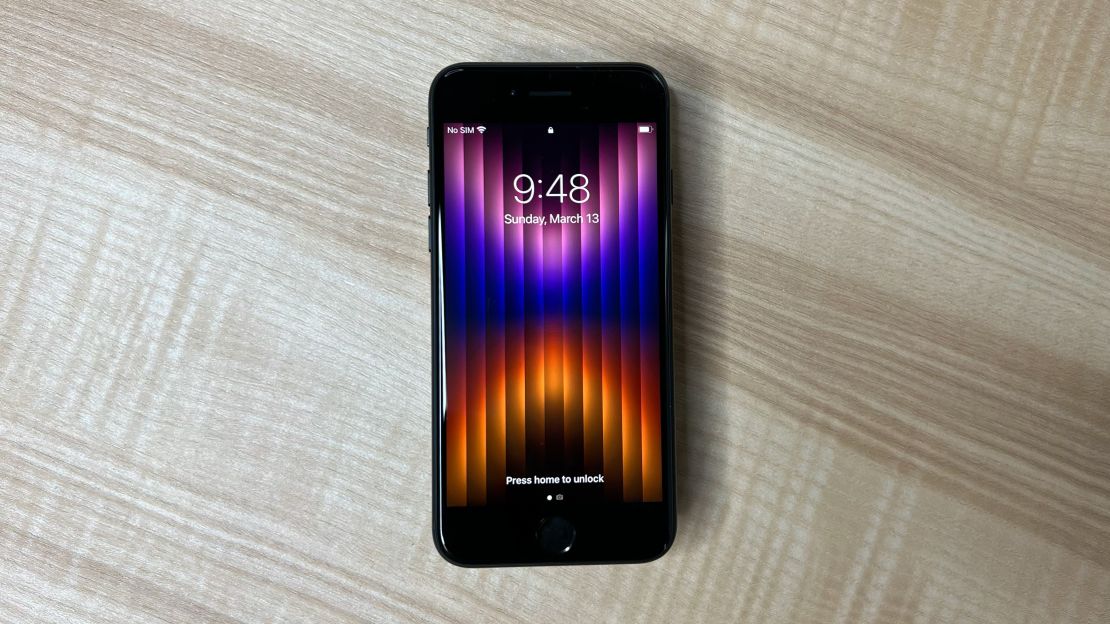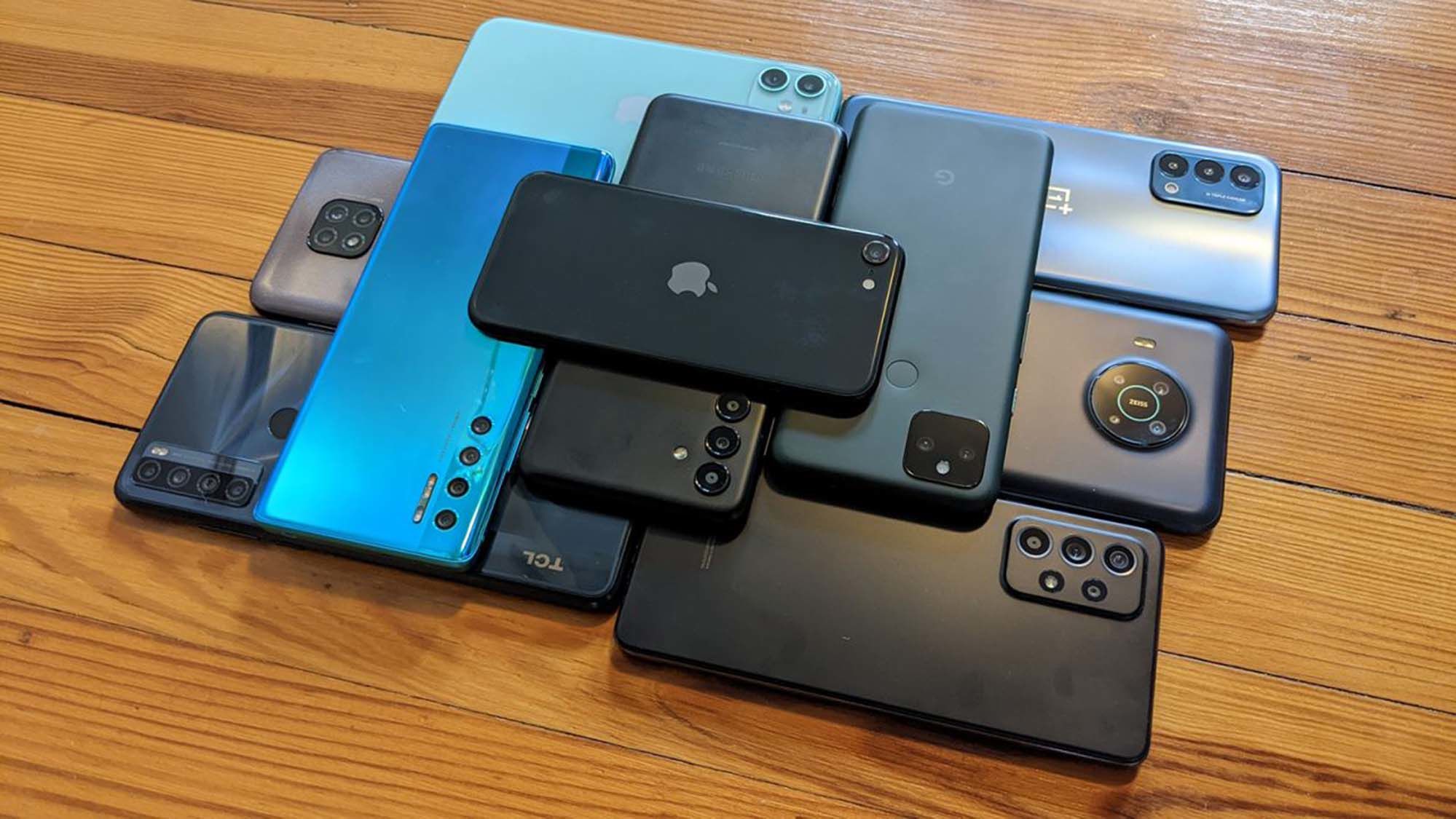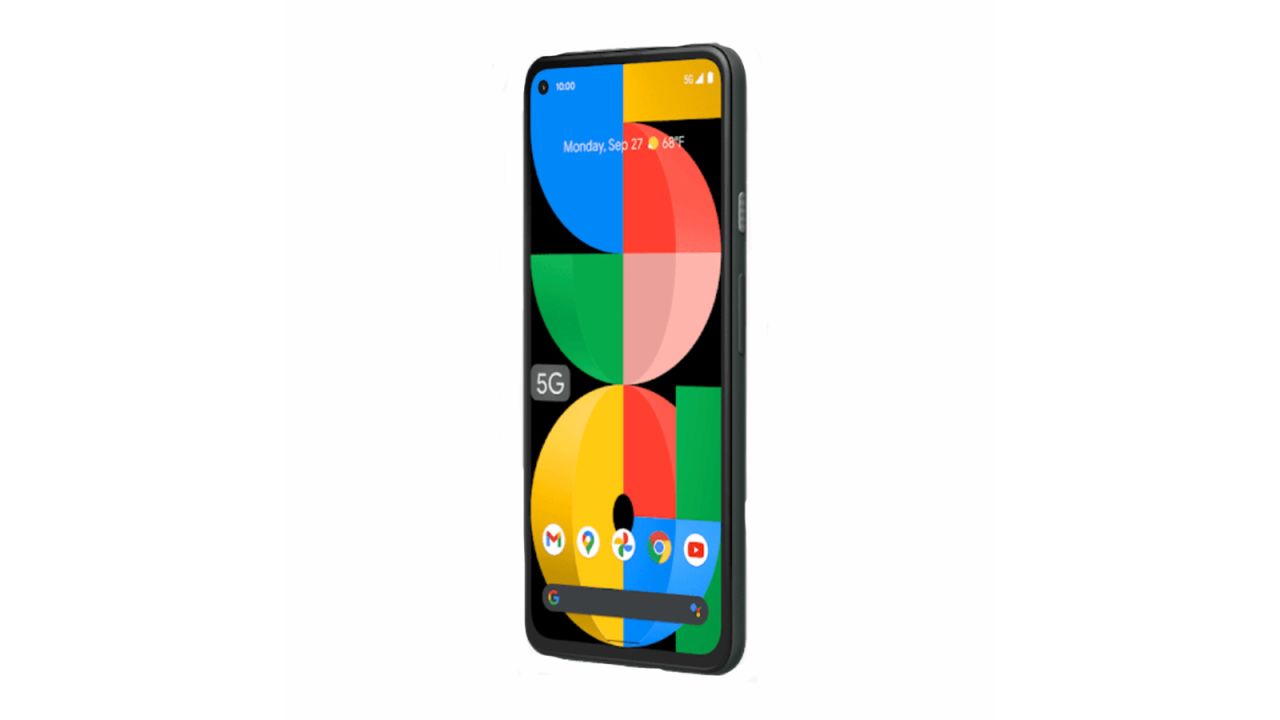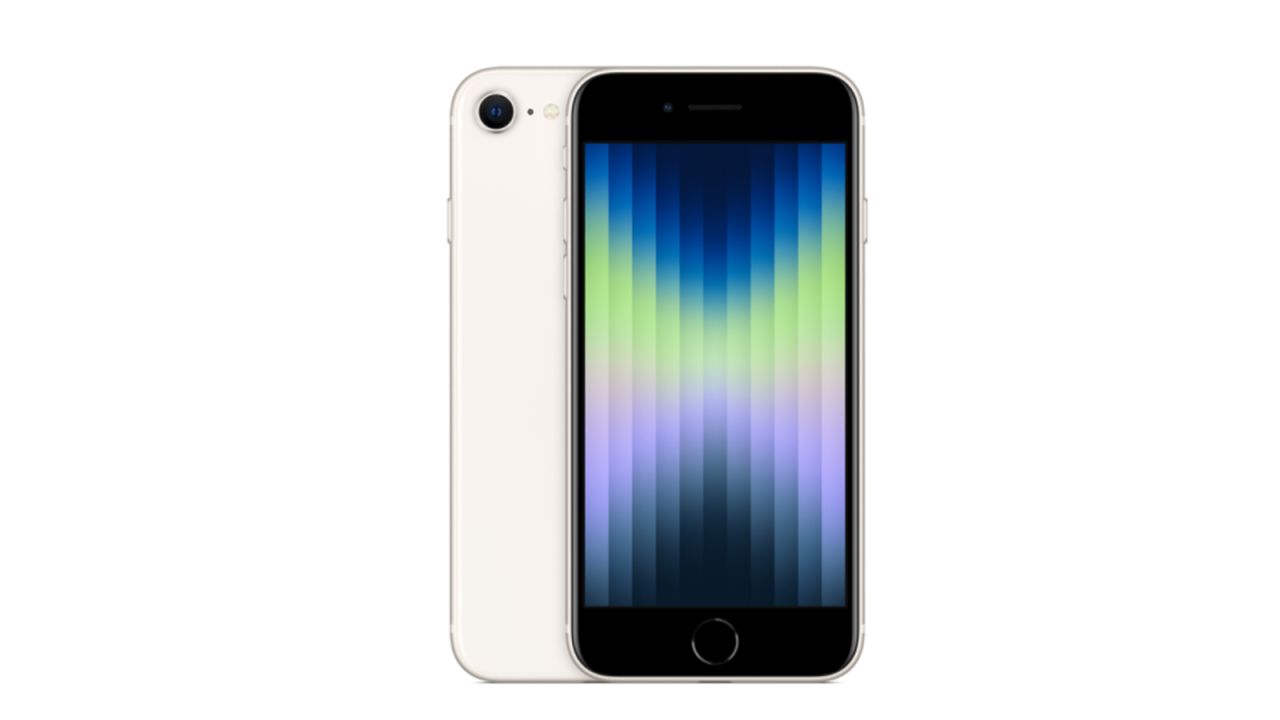These days, flagship phones from Apple and Samsung can cost upwards of $1,000. But you can get a great phone for less than $500, without much compromise. You can still get 5G, a big screen (or one small enough to use one-handed), fingerprint or face unlock — and maybe even a headphone jack, long gone out of fashion on flagship phones.
To find the best budget phones, we put nine smartphones —Apple’s newly refreshed iPhone SE and two older iPhones, plus the leading budget-priced Android devices — through a battery of tests to see which ones offer more than a low, low price.
The best Android phone under $500: Google Pixel 5a with 5G
From $349 unlocked at Google

The Pixel 5a with 5G offers the best value of any phone Google has made yet. For under $500, you get the most up-to-date version of Android, 5G support, IP67 water resistance, and even the traditional convenience of a headphone jack.
The Pixel 5a’s 6.34-inch OLED screen is bright and clear and just meets the test of allowing single-handed use, depending on your hand size. It unlocks with a fingerprint sensor on the back, an older design that allows quick and reliable biometric authentication. And unlike previous a-series Pixels, the 5a features IP67 water and dust resistance.
The 5a’s 5G support is impressively comprehensive. It’s at home on T-Mobile’s fast mid-band 5G, consistently yielding download speeds around 400 Mbps in our D.C.-area testing. And the 5a has the right hardware to operate on AT&T and Verizon’s C-band 5G, although it’s yet to show up on either carrier’s lists of supported C-band devices.
Our test 5a exhibited strong battery life, lasting 10 hours and 49 minutes in our worst-case streaming-video test. It was also the fastest phone to recharge with its included 18W USB-C charger, going from zero to 46% in 30 minutes and needing only an hour and 39 minutes to reach 100%. But wireless charging remains a feature reserved for upmarket Pixel phones. So is storage above 128 GB, which — unlike almost every other Android phone on our list — can’t be augmented with a microSD card.
The 5a underperforms slightly with its cameras. It ships with the same 12.2 megapixel camera as previous models, plus the new addition on the back of a 16-megapixel wide-angle camera. Google’s automated post-shot processing allow this aging hardware to beat the competition in low-light conditions but left skin tones in selfies washed out–and the lack of any optical zoom means this can’t replace a dedicated camera with a decent zoom lens.
The best iPhone under $500: iPhone SE (2022)
From $429 unlocked at Apple

The 2022 iPhone SE is a real throwback, looking much like the old iPhone 8, right down to the big Home button that enables Touch ID fingerprint authentication. And with a 4.7-inch screen, it seems almost comically small next to the other phones we tested. But with the same A15 Bionic processor as the flagship iPhone 13, it performs like a modern phone. Performance benchmarks are in line with the 13, and in use we couldn’t make the device slow down with multiple intense apps. Like the Pixel, it has IP67 water resistance.
While the SE’s camera is an older design, with a single lens covering a 12-megapixel sensor, the new chip enables quicker focus and faster processing times, plus you get access to the machine-learning driven modes such as Photographic Styles and Portrait Mode that we like on Apple’s higher-end phones. And a bigger battery than the old SE meant it had plenty of power to get us through a full day of use.
The iPhone SE even offers 5G support, though only in the sub-6 Ghz and C bands, which won’t give you much of a speed bump over 4G LTE but should provide some futureproofing.
While the SE starts at $429, that model only has 64 GB of memory, which will fill up fast. Most people should get the 128GB version, which still squeaks in under $500.
If you’re considering an iPhone, you’re probably already set on iOS, but if you are thinking about how it stacks up to Android devices, the SE falls short of the Pixel 5a. The SE offers both shorter battery life (by a couple of hours) and smaller screen, and even with the updated processing the camera still underperforms. The SE has no dedicated Night Mode for photos, so if you’re depending on your phone for party photography, the SE is not the best choice.
The iPhone SE should far outlast any Android phone in software support. The Pixel 5a with 5G is only guaranteed updates for 3 years from release — putting it far ahead of any non-Pixel Android phone — while iPhones can expect the latest iOS updates for five or six years. Apple is still updating the first iPhone SE, which launched in 2016.
The iPhone SE charges via Apple’s proprietary Lightning cable and does so slowly on the included 5W charger, although it supports charge rates up to 18W as well as Qi wireless charging, like the iPhone 11. And like other iPhones, the SE lacks a headphone jack; it doesn’t even come with a set of Lightning headphones or an adapter.
The best Android phone under $250: Samsung Galaxy A13 5G
$250 unlocked at Samsung

The A13 offers an exceptionally low price for a 5G smartphone without requiring unreasonable compromises. It’s fully fluent in 5G, with hardware for T-Mobile’s mid-band frequencies (and 400+ Mbps speed-test results to prove it) and AT&T and Verizon’s newer C-band. The former has already added the A13 to its list of supported phones.
The A13’s battery lasted for 10 hours and 34 minutes in our worst-case streaming test, good enough for fifth place and not far behind the Pixel 5a. It does not come with a charger in the box, just a USB-C cable. Samsung says the A13 supports 15W fast charging, and when plugged into a Pixel 5a’s 18W charger after being drained by that battery test, it reached 28% charge in 30 minutes and fully recharged in two hours and 14 minutes.
The A13’s 6.5-in. screen features a 90 Hz refresh rate that can smooth scrolling longer documents. The size of that screen and the slightly thicker profile of this phone, however, make single-handed use more of a challenge. A fingerprint scanner hides in the barely-recessed power button on the side that reliably unlocked the phone. On the back, a trio of cameras can take standard and wide-angle pictures, but don’t expect spectacular output. The processor inside is also nothing special, yielding the second-slowest Geekbench results of the phones we tested. The A13 also lacks water resistance or wireless charging.
The least appealing part of this phone is its preinstalled software. The A13 arrived with Android 11 and did not have an update to Android 12 waiting, although Samsung has made a public commitment to three generations of software updates. The A13 did, however, come bloated by both Samsung (including separate Galaxy Store and Galaxy Shop titles) and third-party apps, a software load that ate up 28% of the 64 GB of storage after installing every available update. You will want to pop a microSD card in to augment that storage.
How we tested

We tested each phone by using it mainly as an app machine: picking it up, unlocking it, and seeing how pleasant it was to use such apps as whatever browser came built in, the camera, the email client… and yes, the phone app.
We checked battery life on these phones with a worst-case test: streaming the NASA TV YouTube stream nonstop on every phone at the same time with screens set at maximum brightness, with each phone on WiFi (and with its cellular radio disabled via airplane mode) to ensure they would all have to deal with the same connectivity.
If they supported 5G, we tested on T-Mobile in indoor and outdoor locations. In the Washington DC area, T-Mobile is the only carrier that offers both low-band and mid-band 5G, with AT&T and Verizon’s mid-band (“C-band,” to be specific) confined to some other markets.
We evaluated their cameras’ performance by taking pictures of the same series of subjects — some indoors, some outdoors, some with worse light than others — using the front and back cameras.
And we noted how each phone felt to use, both in handfeel(including for single-handed use) and in the ease of navigating its built-in apps. With Android phones, we also checked the preinstalled version of Google’s operating system, installed any updates, and noted if they were current with Google’s monthly security patches.
What to know about buying a budget smartphone
Reviews targeted toward phone enthusiasts can leave you lost in benchmarks and acronyms that won’t matter to many people, and only make sense if you’re comparing the very best smartphones out there — which frankly are too much phone for most users. Our advice: don’t worry about the spec sheet competition. Here’s what you should look for.
? Decide whether Android or iPhone suits your needs: iPhones come with much longer software support than Android phones, but fewer hardware options: no removable storage, no headphone jack, etc. Android phones have more hardware variety, but it’s dismayingly rare to see a phone that ships with Android 12, and most vendors only update their phones for a couple of years. Google is an outlier; their budget phones get 3 years of support and the flagship Pixel 6 gets five. You shouldn’t buy an Android phone that doesn’t at least ship with Android 11, and you should make sure it comes with some assurance about how many years of Android updates it will get after purchase.
? Don’t get carried away with screen size: While big phones are impressive, the real question is whether the size works for you every day. Decide whether you can feasibly use the phone with one hand while you push a shopping cart or a stroller, haul rolling luggage or hold on to a stanchion in a subway. A screen smaller than 6.5 inches diagonally makes one-handed use notably easier; people with smaller hands may want something even smaller.
? Don’t skimp on storage: A phone that’s low on storage requires endless maintenance to delete photos, clear app caches or uninstall apps temporarily–especially if the phone doesn’t allow expanding that storage with a microSD card. 64 GB is acceptable with microSD expansion; otherwise, you’ll be happier with 128 GB or more.
? Look for 5G support for the long term: A phone that can use the much faster mid-band 5G frequencies at AT&T, T-Mobile and Verizon will be much more useful than one that’s confined to low-band 5G. Here’s where you need to check the fine print: Support for band “N41” means it works on T-Mobile’s mid-band 5G, while “N77” covers AT&T and Verizon’s just-launched C-band 5G.
Other smartphones under $500 we tested
iPhone 11
From $359 (64GB) unlocked at Amazon
The iPhone SE isn’t the only Apple phone for less than $500. If you want a larger screen and better camera performance and prefer FaceID to TouchID, you can get the 64GB iPhone 11, from 2019, for $489. Unlike the new iPhone SE, though, it lacks 5G support, and the SE’s A15 processor is faster than the A13 used in the iPhone 11.
The iPhone 11 is about a half an inch taller and a third of an inch wider than the iPhone SE, but its screen is much larger (6.1 inches versus 4.7) because it lacks the thick bezels of the SE’s older design. It also takes better photos: in addition to the 12MP camera the SE includes, it also has a 12MP wide-angle lens, higher-resolution front camera, and Night Mode, for better low-light shots.
Buying a three-year-old iPhone is still more reasonable than buying a three-year-old Android phone. A three-year-old Android has likely seen the last of its software updates (Google Pixels are often the exception) but Apple generally supports iPhones for six or more years, so the iPhone 11 should get the latest version of Apple through 2025. Its processor won’t feel snappy as long as the iPhone SE’s will, and cases and other accessories are already harder to find than we’d like. Unlike the 12 and 13, the iPhone 11 doesn’t support MagSafe.
In our battery test, the 11 expired after 8 hours and 43 minutes of video streaming, and because Apple ships it with the same basic 5W charger as the first iPhone, it took nearly 4 hours to fully recharge. It can charge at up to 18W with a USB-PD charger and USB-C-to-Lightning cable, or up to 7.5W with a Qi charger.
Like other iPhones, the 11 suffers from the twin design defects of relying on Apple’s proprietary Lightning cable — so you can’t use the same cable you’d use to charge your MacBook — and not including a headphone jack. And because it only offers Face ID, it was highly annoying to use while wearing a mask, especially with Apple Pay, which requires a separate Face ID authentication even if you already have the phone unlocked.
Samsung Galaxy A52 5G
$399 at Amazon
The A52 5G was the only other phone after the Pixel 5a to have an update to Android 12 available after setup, and it also excelled in our battery-life test by lasting 13 hours and 22 minutes, the longest figure of any phone we tested. Its 6.5-inch display, with a 120 Hz refresh rate, hides an under-screen fingerprint sensor that kept asking us to keep a finger in place longer before unlocking the phone. The side-mounted fingerprint reader on the cheaper A13 was faster and less fussier.
The A52 suffers further from the same bloatware issues as the A13, plus some unnecessary mystery about its 5G support. Samsung’s specs only list a subset of the 5G bands this phone supports– we know, because we saw the A52 hit speeds only possible on T-Mobile mid-band 5G and because FCC data (hat tip to Phone Scoop for linking to them) show that it’s got the right hardware for C-band. But when neither Samsung nor AT&T or Verizon offer any hint about C-band support, buying this phone feels like more of a risk.
TCL 20 Pro 5G
$285 at TCL
The “marine blue” color of the loaner Pro 5G made this the easiest phone to pick out of the lineup, and TCL further distinguishes this model by including 2x optical zoom on one of the four back cameras, Qi wireless charging, water and dust resistance, and a generous 256 GB of storage that make all the preinstalled apps a little less objectionable.
But the way the 6.67-in, display curve past the edges makes it too easy to select something on the screen when you’re just trying to pick up the phone. Battery life, at 9:23 in our streaming-video test, put this in the bottom half of the pack. And the Pro 5G not only does not support C-band, its lack of a CDMA radio limits its compatibility on Verizon.
Moto G Power
$300 $250 at Motorola
Motorola’s sales pitch for this older model leads off with long battery life, and our G Power did yield the second-longest battery life in our worst-case test, at 11 hours and 12 minutes of continuous YouTube streaming. But it also charged slower than almost every other phone tested, remained months behind with Google’s security patches after checking for updates, and, alongside the TCL 20 SE, lacked both 5G and NFC for mobile payments.
OnePlus Nord N200 5G
$240 $150 unlocked at OnePlus
The N200 5G, like the TCL 20 Pro 5G, lacks both C-band support and a CDMA radio, and its overall 5G support is so limited that it’s a 4G phone on Verizon. The N200 did offer strong battery life, lasting 10:59 in our worst-case test, a smoother-scrolling 90 Hz 6.49-inch. display, and an unusually restrained software installation that left it with more free storage space than any other 64 GB Android phone. It also comes with both fingerprint and facial biometrics. The latter worked even when I wore a mask, which makes me suspect it’s not secure enough.
Nokia X100
Currently unavailable
The X100 is only available through T-Mobile, but the lack of C-band 5G support should make it a non-starter for AT&T and Verizon users anyway. The review X100 delivered perhaps the most disappointing battery-life results, lasting just 7:20 in our streaming-video test despite having one of the higher-capacity batteries among all the phones tested. Nokia does have a software-update policy posted–specifying “2 years of monthly security updates”–and ships an Android configuration pleasantly close to stock Android, but it’s yet to ship Android 12 for the X100.




















